
Fuchsia is a genus of flowering plants that consists mostly of shrubs or small trees. The first to be scientifically described, Fuchsia triphylla, was discovered on the Caribbean island of Hispaniola about 1696–1697 by the French Minim friar and botanist, Charles Plumier, during his third expedition to the Greater Antilles. He named the new genus after German botanist Leonhart Fuchs (1501–1566).
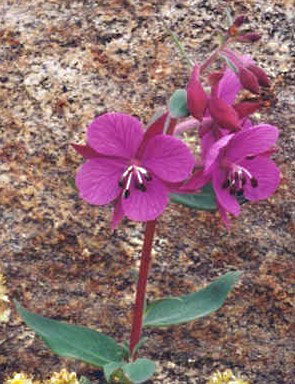
The Onagraceae are a family of flowering plants known as the willowherb family or evening primrose family. They include about 650 species of herbs, shrubs, and trees in 17 genera. The family is widespread, occurring on every continent from boreal to tropical regions.

Fuchsia magellanica, commonly known as the hummingbird fuchsia or hardy fuchsia, is a species of flowering plant in the evening primrose family Onagraceae, native to the lower Southern Cone of southern South America.
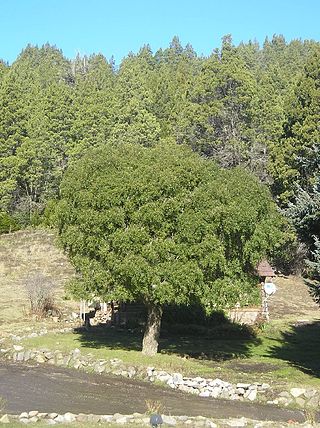
Maytenus is a genus of flowering plants in the family Celastraceae. Members of the genus are distributed throughout Central and South America, Southeast Asia, Micronesia and Australasia, the Indian Ocean and Africa. They grow in a very wide variety of climates, from tropical to subpolar. The traditional circumscription of Maytenus is paraphyletic, so many species have been transferred to Denhamia, Gymnosporia, Monteverdia, and Tricerma.

Voluta is a genus of medium to large sea snails, marine gastropod molluscs in the family Volutidae, the volutes.

Acaena magellanica, commonly called buzzy burr or greater burnet, is a species of flowering plant whose range includes the southern tip of South America and many subantarctic islands.
Admete magellanica is a species of sea snails, a marine gastropod mollusc in the family Cancellariidae, the nutmeg snails.

Odontocymbiola is a genus of sea snails, marine gastropod mollusks in the subfamily Cymbiinae of the family Volutidae.
Molinaranea magellanica is a species of orb-weaver spider endemic to Chile, Argentina, the Juan Fernández Islands and the Falkland Islands. It is also known as the Falklands green spider. It is the largest endemic spider known to exist in the Falklands.

Paranotothenia magellanica, also known as Magellanic rockcod, Maori cod, blue notothenia or orange throat notothen, is a species of marine ray-finned fish, belonging to the family Nototheniidae, the notothens or cod icefishes. It is native to the Southern Ocean. "Maori chief" and "black cod", sometimes used for this species, usually refer to fishes from the related genus Notothenia. Being a perciform fish, it is unrelated to the true cods of the order Gadiformes. This species is commercially important as a food fish.
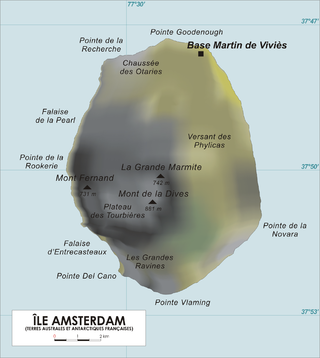
The Plateau des Tourbières comprises the highest upland region of Amsterdam Island, a small French territory in the southern Indian Ocean. Over 500 m above sea level, it contains the island's highest peaks: Mont de la Dives (881 m), Grande Marmite (742 m) and Mont Fernand (731 m).

Luidia is a genus of starfish in the family Luidiidae in which it is the only genus. Species of the family have a cosmopolitan distribution.

Pupatonia is a genus of minute sea snails, marine gastropod mollusks in the family Eatoniellidae, the eatoniellids.
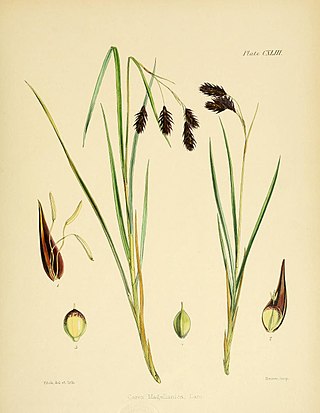
Carex magellanica, or the boreal bog sedge, is a Carex species that is native to North America. It is listed as endangered in Connecticut.
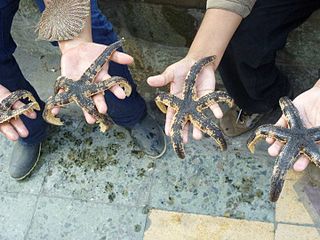
Luidia magellanica is a species of starfish in the family Luidiidae. It is found in the southeastern Pacific Ocean on the coast of South America.

Beania magellanica is a species of colonial bryozoan in the family Beaniidae. It has a cosmopolitan distribution, occurring in shallow waters in the Atlantic and Pacific Oceans and in Antarctica.

Pupatonia gracilispira is a species of marine gastropod mollusc in the family Eatoniellidae. First described by Baden Powell in 1933 as Estea gracilispira, it is endemic to the waters of New Zealand.
Pupatonia atoma is a species in the genus Pupatonia.
Pupatonia minutula is a species in the genus Pupatonia.
Pupatonia pupinella is a species in the genus of Pupatonia.













